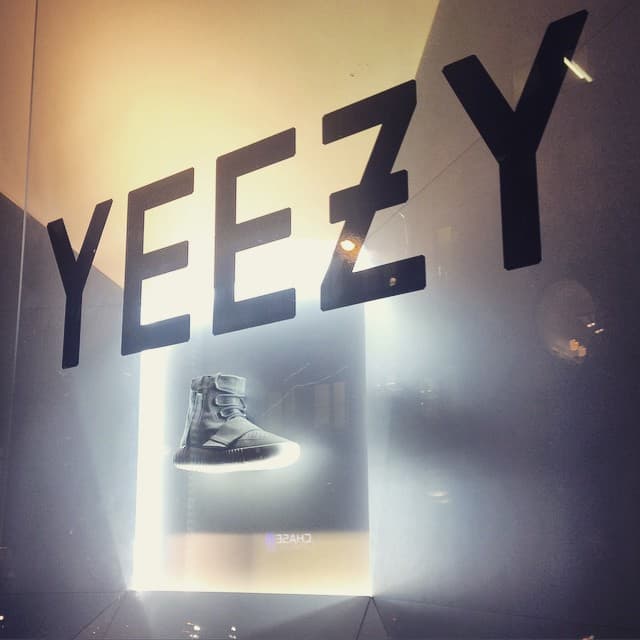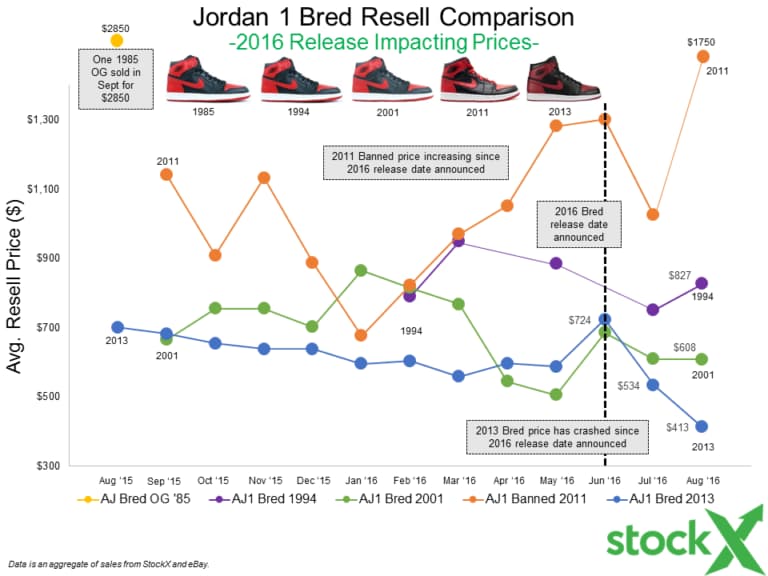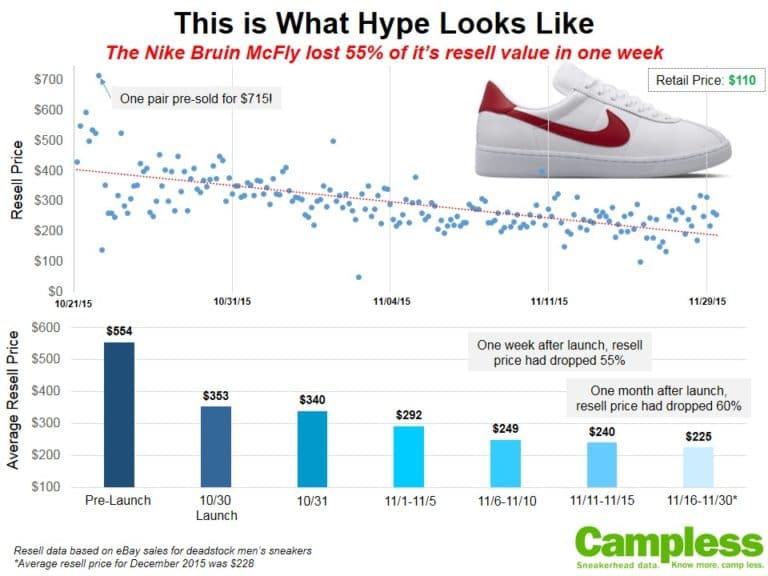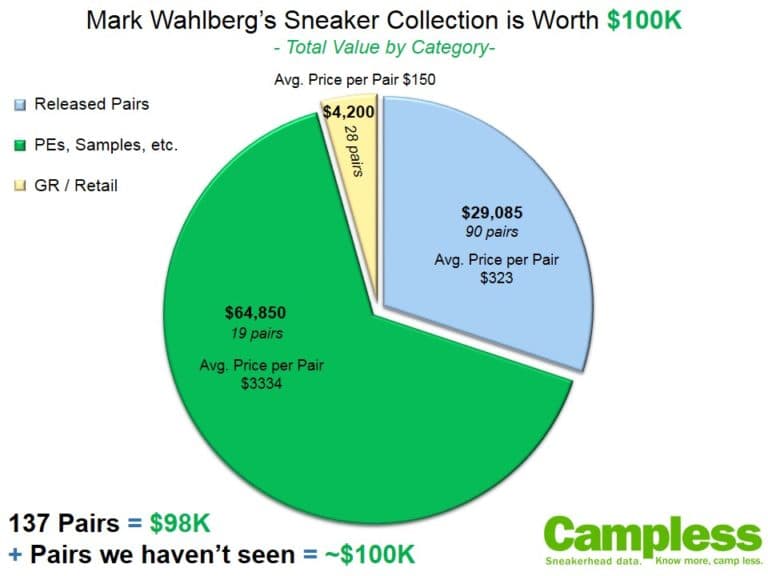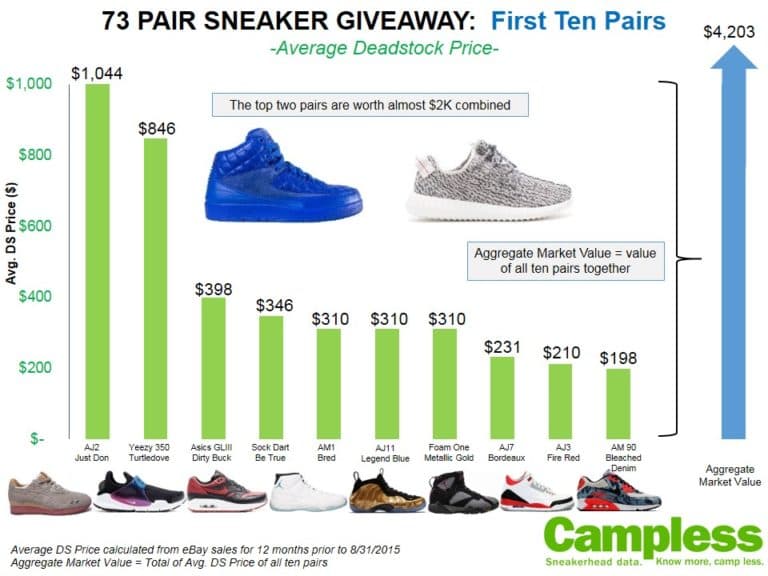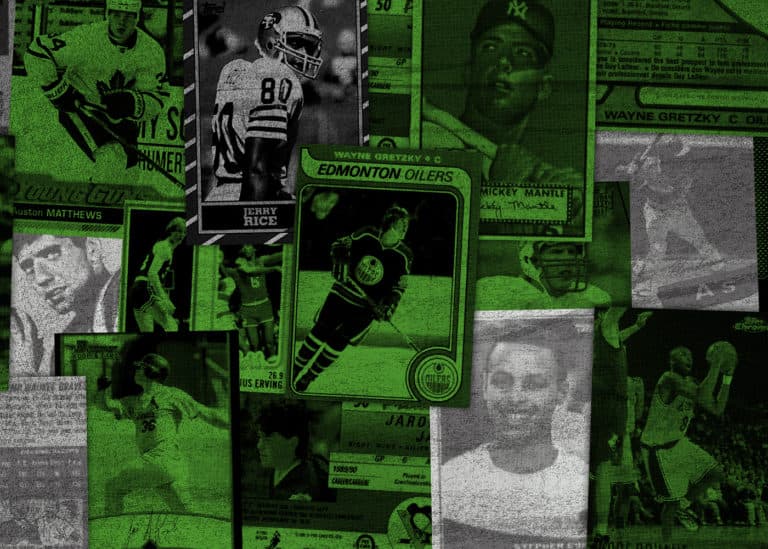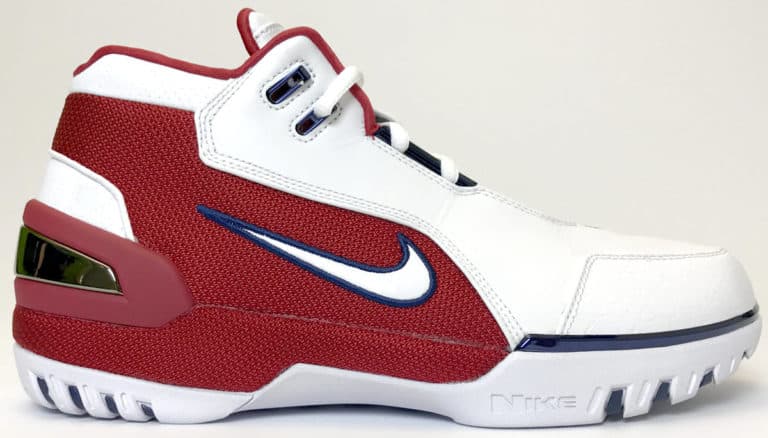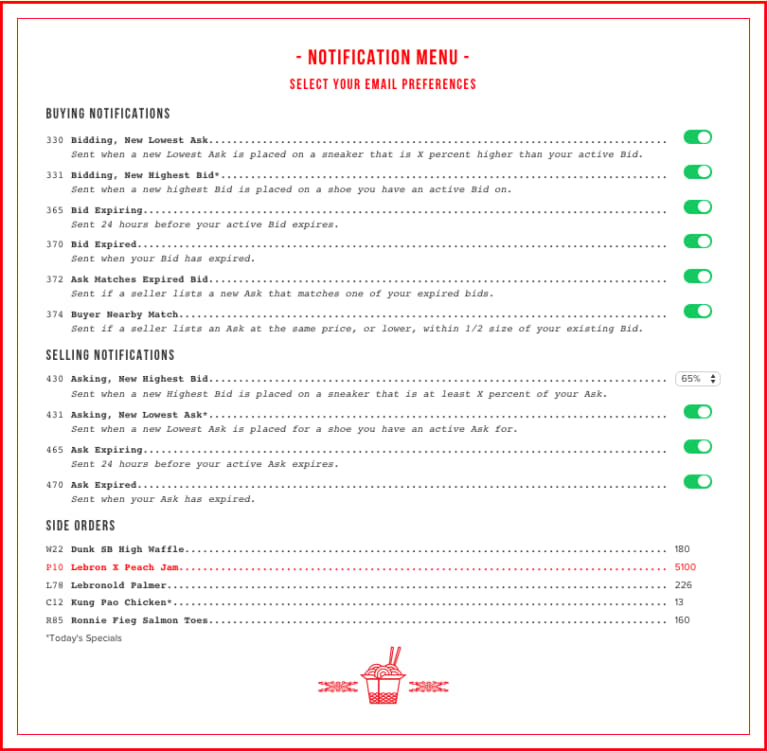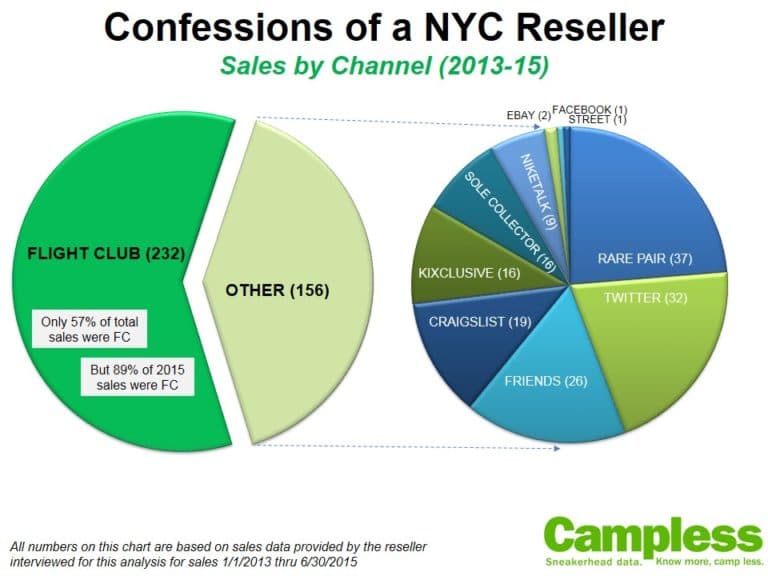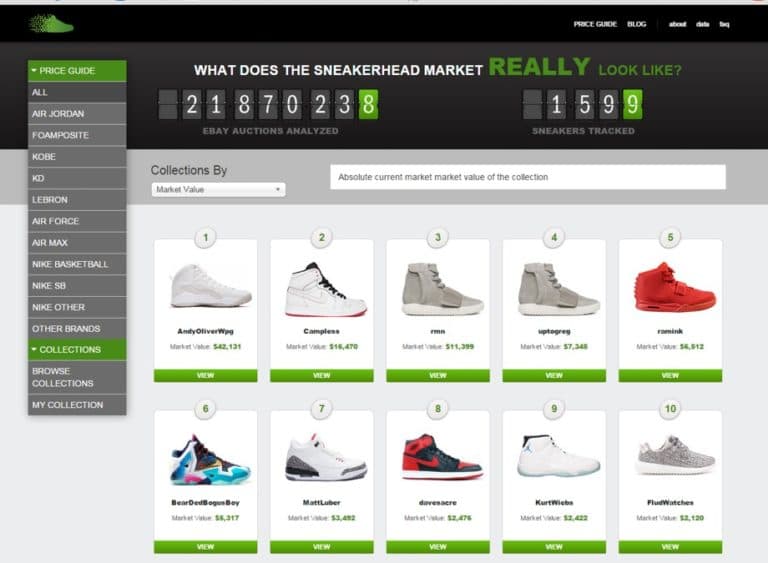Kanye is Jordan . . .
In a previous post, I wrote: “Kanye is this generation’s Jordan. There. I said it.”
I believe that.
Kanye transcends all facets of life for Millennials, not unlike the way Jordan did for me . . . many years ago.
I still root for MJ in HORSE against Bird (“off the wall, nothin’ but net”), and get chills when I hear “Sometimes I dream, that he is me. . .” While writing this post I unplugged the headphones from my computer, turned the sound all the way up and played the iconic Gatorade commercial. Every person over 30 in ear-shot immediately lit up, smiles ear-to-ear, prompting one guy to say, “Can you put that on repeat for the rest of the day?”
This undeniable and permanent reverence is at least partly responsible for Air Jordans’ historical dominance of the resell market. Through 2014, Nike, including Jordan Brand, accounted for 96% of the sneaker resell market.
. . . and Yeezys resell like Air Jordans used to . . .
But that number has dropped consistently and considerably since February 2015 – when adidas launched the Yeezy. Since then adidas has taken more share of the resell market with every release and is, currently, about 30% of the market. NMDs and Ultra Boosts have surely helped that growth, but there is no debate that Kanye has been directly responsible. In the last 12 months there have been over $22M worth of adidas Yeezy’s resold on eBay alone.
. . . but does Kanye move the retail needle?
What is up for debate, however, is how much impact Kanye has had on adidas’ retail sales growth over the past two years.
Some industry analysts have long-since derided Kanye’s impact, going so far as to disregard any potential halo effect that the pop culture icon has on the brand, as a whole. “Making the brand cooler doesn’t show up in the data”, they say, and they’ve consistently said that the data doesn’t support Kanye’s impact on adidas retail sales.
I don’t know what data they are talking about. I’ve never seen any charts but I can preemptively say that pointing to Yeezy retail sales data alone doesn’t make sense to me as a holistic analysis of Kanye’s impact. But then again, I’m not a retail data analyst.
So I asked one.
Introducing a retail sneaker data expert:
Neil Schwartz is the Vice President of Market Insights and Business Development at SportsOneSource – universally recognized as one of, if not the, top market research firm for the athletic footwear market. Neil has been analyzing retail sneaker data since 1999.
I was fortunate enough to speak with him about adidas and Kanye:
An Interview with Neil Schwartz
Josh: Thanks for taking the time to talk today, Neil. Let’s jump right in. My understanding is that there was a recent Foot Locker earnings call with a heavy focus on adidas.
Neil: My pleasure. Yes, in the Foot Locker Q2 earnings call, CEO Dick John specifically called out the adidas brand and the success of their classic styles with Millennials.
Josh: From your tone, I take it that this statement from the CEO of Foot Locker came as a surprise to you and your colleagues?
Neil: This statement did more than [that], it sent shock waves down the back of my spine. Imagine that, the most fickle, elusive and mysterious of all demographic generations have decided to embrace classic styles from adidas. Given the current deceleration in the Basketball category, this new normal is a good thing for the brand and also retailers.
Josh: Does the data that SportsOneSource is seeing back this up?
Neil: According to SSIData [SportsOneSource data], adidas overall sales are up 35% for the current YTD [through mid-August 2016]. Much of this growth is coming from the Casual Athletic Categories with a huge assist from Running. In 17 years in the Athletic and Sports Footwear category of business, I have rarely seen a brand experience the kind of growth that adidas has over the past year. For the past three years, adidas footwear sales have been languishing in mediocrity and now all of the sudden adidas has become a superstar brand for many retailers. No pun intended.
Josh: What about the qualitative side of things?
Neil: I have to admit that I spend a great deal of time looking at what people are wearing on their feet. I seem to spend a lot of time in airports and yes, shopping malls trying to get a feel for what is trending beyond what I can see from the SSIData. Everywhere I go, I see more and more people wearing the classic Stan Smith sneakers in the traditional white leather with green trim along with the familiar adidas Superstar with the hard Shell Toe. When I look to see who is wearing them, I see young college age or younger women wearing these classic shoes. I also see an abundance of the Campus Suedes, Sambas and others. Back to the hard data, the Superstar maintains 5 of the top 10 best-selling styles for adidas in the Casual Athletic category of footwear sales.
Josh: Outside of the perennial adidas classics, what are some of the other models that you think are driving the three stripes forward?
Neil: The new adidas NMD, or Nomad as it is called, appears to be on the brink of the new breakout shoe that will propel adidas forward for the next year or so. Right now the NMD is being released in limited quantities and to a limited number of retailers. And if you subscribe to the theory that a rising tide lifts all boats, then just watch the Ultra Boost, Boost ZG and Pure Boost take their place in the adidas stable of quality styles. The Boost product from adidas has finally seemed to catch on, especially as a casual running style.
Josh: And what about Kanye and the Yeezy?
Neil: I follow the StockX data. I know Yeezys resell for thousands of dollars. I finally started to put two and two together. It is the success of the adidas partnership with Kanye West that is contributing to this positive story. When you combine that with the fact that Kim Kardashian has 80 million plus Instagram followers, you start to see what’s going on. The shoes are cool but, frankly, the influence is more important. [Ed. – Kim has 47.5M Twitter followers; 29M Facebook; 80.5M IG; Kanye has 25M Twitter; 9.5M Facebook; not on IG].
Josh: Others have argued that adidas sales increase is a function of better product – NMD, Boost, etc. Is that true?
Neil: Absolutely. But it’s not the only factor. How do you explain such a large increase in classics? Those products have been there forever. When a Millennial can’t get a Yeezy at retail, he/she is much more likely to wear another adidas product.
Josh: So what’s your overall opinion of Kanye as an ambassador for adidas?
Neil: Kudos to adidas! They found the one messenger for the brand that could finally find the answer to marketing to Millennials. It’s not just the message . . . it’s also about the messenger. Product, message, messenger. Adidas is nailing all three right now.


